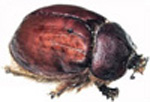 |
|
 |
|
 Though Cochineal (E120 or C.I. 75470) is the commonly-known name for the red bug, cantharidine, carminic acid (natural red 4), carmine (aluminium chelate of carminic acid) and crimson lake are synonyms.
Though Cochineal (E120 or C.I. 75470) is the commonly-known name for the red bug, cantharidine, carminic acid (natural red 4), carmine (aluminium chelate of carminic acid) and crimson lake are synonyms.
About 150 to 180 tonnes of cochineal is produced annually and utilised worldwide. 90% of the total production comes from Peru; the balance from the Canary Islands. About 62 Peruvian suppliers sell it to only 6-7 European, 5-6 American and 2 Japanese buyers who hold the trade monopoly.
Cochineal is a Mexican cactus insect parasite. They are flat, wingless, 5 mm long, oval shaped scale insects. A red colouring agent obtained from the females after they are killed by immersing in hot water, dried and crushed to a fine powder, has been used for dyeing fabrics, particularly wool, for centuries. It is a very common ingredient in cosmetics, hair oils, paints and medicines today.
|
Eating Red Bugs
|
In some countries, if cochineal is used as a “natural food colouring,” it must be stated on the label, as it can cause toxic and allergic reactions. For example, it can be an ingredient of tomato products, jams, desserts, confectionery, and Maraschino cherries to make them look bright red. However, 2007 onwards cochineal was discontinued as an ingredient in Campari, a red Italian bitter wine often used in cocktails.
India has banned the use of cochineal in foods but this red colouring is ironically easily available as its use is permitted in the pharmaceutical industry for coating allopathic pills, as well as for colouring medicines and ointments.
The crimson dye used to colour fabrics, such as traditional woollen Jamawar shawls, is from cochineal insects. 70,000 insects are killed to produce 500 grams dye.
In India these bugs, called beerbahooti, are found during the monsoons. Unani cures for paralysis include cooking them in oil and, for typhoid, suffocating them to death.
Kermes, kermesic acid or chermes (meaning red/crimson in Farsi) is derived from another crushed insect. In fact, kermes, cochineal, lac and Chinese insects are all crushed bodies of the same family of scale insects. (80% of the world’s shellac derived from lac insects is produced in India.)
Polish cochineal is a dye also derived from an insect, but only used for textiles, not foods.
|
Alternatives
|
Cochineal Red is an azo dye (E124 or C.I. 16255) which has nothing to do with actual cochineal and is vegan (coal tar), but it is named so since it produces a similar red colour. It is also called Ponceau 4R, C.I. Acid Red 18, Brilliant Scarlet 3R, New Coccine and SX purple. In USA, Norway and Finland, Ponceau 4R is considered carcinogenic therefore banned, but not so in India.
Red aniline dyes like 2 and 40 (considered vegan as products of coal tar) used in place of cochineal in foods and drinks are believed to be carcinogenic. Red 3, Yellow 5 and Yellow 6 are also linked to cancer.
Pomegranate, annatto seeds, madder roots, beetroot, paprika fruits, tomatoes, raspberry, cutch heartwood (katha consumed in paan), and red onion skins produce shades of red and pink colours which can easily replace insect dyes.
|
|
|
Page last updated on 22/10/24 |
|
|
 |
|
 |
|
|